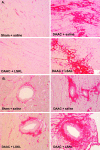A thrombospondin-1 antagonist of transforming growth factor-beta activation blocks cardiomyopathy in rats with diabetes and elevated angiotensin II
- PMID: 17640965
- PMCID: PMC1959499
- DOI: 10.2353/ajpath.2007.070056
A thrombospondin-1 antagonist of transforming growth factor-beta activation blocks cardiomyopathy in rats with diabetes and elevated angiotensin II
Abstract
In diabetes and hypertension, the induction of increased transforming growth factor-beta (TGF-beta) activity due to glucose and angiotensin II is a significant factor in the development of fibrosis and organ failure. We showed previously that glucose and angiotensin II induce the latent TGF-beta activator thrombospondin-1 (TSP1). Because activation of latent TGF-beta is a major means of regulating TGF-beta, we addressed the role of TSP1-mediated TGF-beta activation in the development of diabetic cardiomyopathy exacerbated by abdominal aortic coarctation in a rat model of type 1 diabetes using a peptide antagonist of TSP1-dependent TGF-beta activation. This surgical manipulation elevates initial blood pressure and angiotensin II. The hearts of these rats had increased TSP1, collagen, and TGF-beta activity, and cardiac function was diminished. A peptide antagonist of TSP1-dependent TGF-beta activation prevented progression of cardiac fibrosis and improved cardiac function by reducing TGF-beta activity. These data suggest that TSP1 is a significant mediator of fibrotic complications of diabetes associated with stimulation of the renin-angiotensin system, and further studies to assess the blockade of TSP1-dependent TGF-beta activation as a potential antifibrotic therapeutic strategy are warranted.
Figures





References
-
- Fonarow GC, Srikanthan P. Diabetic cardiomyopathy. Endocrinol Metab Clin North Am. 2006;35:575–599, ix. - PubMed
-
- Asbun J, Villarreal FJ. The pathogenesis of myocardial fibrosis in the setting of diabetic cardiomyopathy. J Am Coll Cardiol. 2006;47:693–700. - PubMed
-
- Poornima IG, Parikh P, Shannon RP. Diabetic cardiomyopathy: the search for a unifying hypothesis. Circ Res. 2006;98:596–605. - PubMed
-
- Factor SM, Minase T, Bhan R, Wolinsky H, Sonnenblick EH. Hypertensive diabetic cardiomyopathy in the rat: ultrastructural features. Virchows Arch A Pathol Anat Histopathol. 1983;398:305–317. - PubMed
Publication types
MeSH terms
Substances
Grants and funding
- HL50061/HL/NHLBI NIH HHS/United States
- S10 RR019231/RR/NCRR NIH HHS/United States
- P30 DK74038/DK/NIDDK NIH HHS/United States
- R01 HL050061/HL/NHLBI NIH HHS/United States
- P30 DK074038/DK/NIDDK NIH HHS/United States
- P50 AT00477/AT/NCCIH NIH HHS/United States
- CO6 RR 15490/CO/NCI NIH HHS/United States
- HL31515/HL/NHLBI NIH HHS/United States
- P30 CA013148/CA/NCI NIH HHS/United States
- P50HL077100/HL/NHLBI NIH HHS/United States
- P50 AT000477/AT/NCCIH NIH HHS/United States
- DK60658/DK/NIDDK NIH HHS/United States
- P30 CA13148/CA/NCI NIH HHS/United States
- P50 HL077100/HL/NHLBI NIH HHS/United States
- R01 DK060658/DK/NIDDK NIH HHS/United States
- U54 CA100949/CA/NCI NIH HHS/United States
- P30 AR050948/AR/NIAMS NIH HHS/United States
- S10 RR19231/RR/NCRR NIH HHS/United States
- C06 RR015490/RR/NCRR NIH HHS/United States
LinkOut - more resources
Full Text Sources
Other Literature Sources
Medical
Molecular Biology Databases
Miscellaneous

